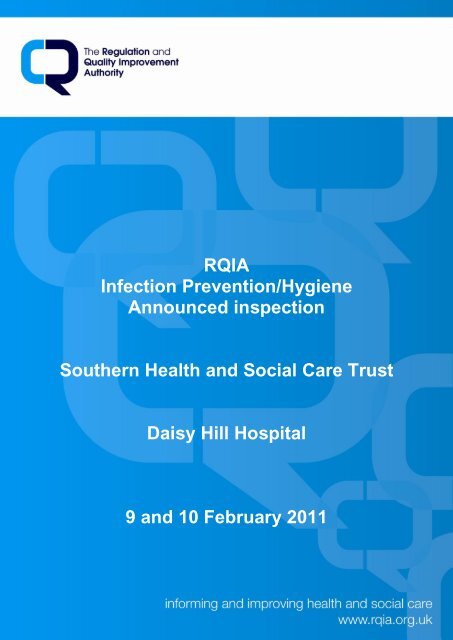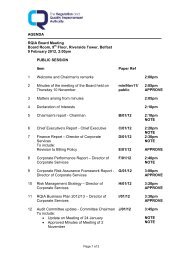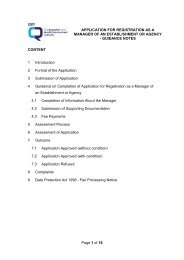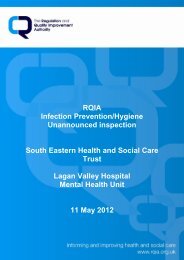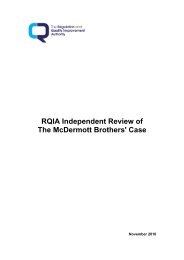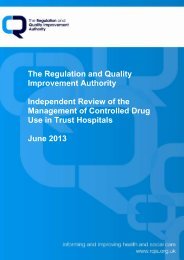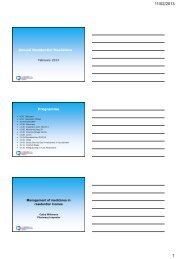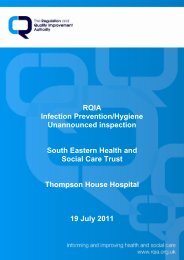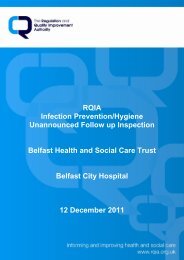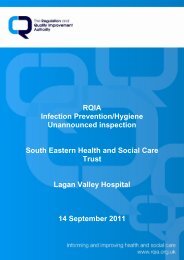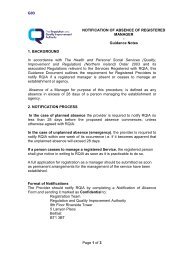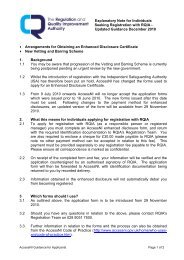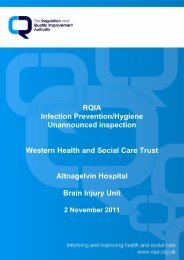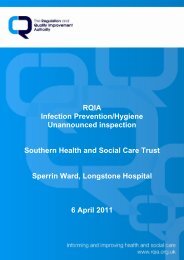Daisy Hill Hospital, Newry - Regulation and Quality Improvement ...
Daisy Hill Hospital, Newry - Regulation and Quality Improvement ...
Daisy Hill Hospital, Newry - Regulation and Quality Improvement ...
Create successful ePaper yourself
Turn your PDF publications into a flip-book with our unique Google optimized e-Paper software.
RQIA<br />
Infection Prevention/Hygiene<br />
Announced inspection<br />
Southern Health <strong>and</strong> Social Care Trust<br />
<strong>Daisy</strong> <strong>Hill</strong> <strong>Hospital</strong><br />
9 <strong>and</strong> 10 February 2011
Contents<br />
1.0 Inspection Summary 1<br />
2.0 Background Information to The Inspection Process 6<br />
3.0 Inspections 7<br />
4.0 Announced Inspections 8<br />
4.1 Announced Inspection Process 8<br />
4.2 Self Assessment 8<br />
4.3 Pre-Inspection Analysis 8<br />
4.4 Onsite Inspection 8<br />
4.5 Feedback <strong>and</strong> Report of the Findings 8<br />
5.0 Audit Tool 10<br />
6.0 Organisational Systems <strong>and</strong> Governance 12<br />
6.1 Criterion 1.1 12<br />
6.2 Criterion 1.2 16<br />
6.3 Criterion 1.3 19<br />
6.4 Criterion 1.4 21<br />
6.5 Criterion 1.5 25<br />
6.6 Criterion 1.6 27<br />
7.0 Environment 29<br />
7.1. Cleaning 29<br />
7.2 Clutter 30<br />
7.3 Maintenance <strong>and</strong> Repair 31<br />
7.4 Fixture <strong>and</strong> Fittings 31<br />
7.5 Information 31<br />
8.0 Patient Linen 33<br />
8.1 Management of Linen 33<br />
9.0 Waste <strong>and</strong> Sharps 34<br />
9.1 Waste 34<br />
9.2 Sharps 34<br />
10.0 Patient Equipment 36<br />
11.0 Hygiene Factors 38<br />
12.0 Hygiene Practices 40<br />
13.0 Key Personnel <strong>and</strong> Information 42<br />
14.0 Summary of Recommendations 43<br />
15.0 Announced Inspection Flowchart 45<br />
16.0 RQIA Hygiene Team Escalation Policy Flowchart 47<br />
17.0 Action Plan 48
1.0 Inspection Summary<br />
This is the report of the announced inspection undertaken to the<br />
Southern Health <strong>and</strong> Social Care Trust (SHSCT) <strong>and</strong> the <strong>Daisy</strong> <strong>Hill</strong><br />
<strong>Hospital</strong> on 9 <strong>and</strong> 10 February 2011. The trust <strong>and</strong> hospital were<br />
assessed against the Draft Regional Healthcare Hygiene <strong>and</strong><br />
Cleanliness St<strong>and</strong>ards.<br />
The inspection found that the SHSCT has organisational <strong>and</strong><br />
governance systems in place to comply with st<strong>and</strong>ard one of the<br />
'Regional Healthcare Hygiene <strong>and</strong> Cleanliness St<strong>and</strong>ards'.<br />
The findings of the inspection indicated that further work is required to<br />
ensure that key polices/procedures <strong>and</strong> strategies are available,<br />
processed efficiently <strong>and</strong> are available for all staff to access on the<br />
trust intranet.<br />
Further work is required on providing assurance on training needs<br />
assessments <strong>and</strong> the uptake of m<strong>and</strong>atory training. The trust should<br />
also strengthen <strong>and</strong> develop user involvement which assists with the<br />
overall process of public assurance.<br />
During the inspection of the <strong>Daisy</strong> <strong>Hill</strong> <strong>Hospital</strong> the following areas<br />
were inspected:<br />
Male Medical <strong>and</strong> CCU Ward<br />
Female Surgical Ward<br />
The hospital is a local general hospital based in the border city of<br />
<strong>Newry</strong>. It is part of the Southern Health <strong>and</strong> Social Care Trust,<br />
provides health <strong>and</strong> social services to the council areas of Armagh<br />
Craigavon, Banbridge, <strong>Newry</strong> <strong>and</strong> Mourne <strong>and</strong> Dungannon <strong>and</strong> South<br />
Tryone. Facilities in the hospital include:<br />
24 hour Emergency Department<br />
Medicine<br />
Surgery<br />
Obstetrics<br />
Gynaecology<br />
ENT<br />
Paediatrics<br />
Coronary Care Unit<br />
Surgical High Dependency Unit<br />
Day Procedure Unit<br />
Radiography Department<br />
Outpatients Departments<br />
Theatres<br />
Haemodialysis Unit<br />
1
The professions allied to medicine (Physiotherapy, Occupational<br />
Therapy, Cardiology Investigation, Chiropody <strong>and</strong> Dietetics) are all on<br />
site, together with a 24 hour laboratory service.<br />
Inspection Outcomes<br />
The Male Medical Ward <strong>and</strong> Female Surgical Ward have undergone<br />
recent refurbishment, this is still ongoing at present to improve storage<br />
facilities in both areas. The compliance levels achieved are to be<br />
commended, inspectors observed that both environments were clean,<br />
tidy <strong>and</strong> in good repair. A small number of issues were identified for<br />
improvement but overall the observation of staff indicated that they<br />
were compliant with hygiene <strong>and</strong> infection prevention control practices.<br />
The inspection resulted in 21 recommendations for the SHSCT <strong>and</strong> the<br />
<strong>Daisy</strong> <strong>Hill</strong> <strong>Hospital</strong>, a full list of recommendations is listed in Section 13.<br />
A detailed list of preliminary findings is forwarded to SHSCT within 14<br />
days of the inspection to enable early action on identified areas which<br />
have achieved non complaint scores. The draft report which includes<br />
the high level recommendations in a <strong>Quality</strong> <strong>Improvement</strong> Plan is<br />
forwarded within 28 days of the inspection for agreement <strong>and</strong> factual<br />
accuracy. The draft report is agreed <strong>and</strong> a completed action plan is<br />
returned to RQIA within 14 days from the date of issue. The detailed<br />
list of preliminary findings is available from RQIA on request.<br />
The final report <strong>and</strong> <strong>Quality</strong> <strong>Improvement</strong> Plan will be available on the<br />
RQIA website. Reports <strong>and</strong> action plans will be subject to performance<br />
management by the Health <strong>and</strong> Social Care Board <strong>and</strong> the Public<br />
Health Agency.<br />
Notable Practice<br />
The inspection identified the following areas of notable practice<br />
The trust has met its target reductions in the number of<br />
MRSA <strong>and</strong> Clostridium difficile infections. Of particular note<br />
is the 77 per cent reduction in Clostridium difficile infections<br />
which is the largest reduction of any of the trusts within<br />
Northern Irel<strong>and</strong>.<br />
The SHSCT is an accredited centre for BICS (British Institute<br />
Cleaning Science) training for domestic staff. The trust has<br />
adapted this training to suit the needs of the service. A<br />
strategy is in place to ensure all staff receive this level of<br />
training which provides staff with a 'Cleaners Operative<br />
Proficiency Certificate' (COPC) Level 1.<br />
An electronic dashboard computer software programme has<br />
been introduced, this provides up to date information on<br />
2
audits <strong>and</strong> of performance against care bundles <strong>and</strong> other<br />
interventions aimed at reducing infection.<br />
There are effective internal monitoring systems in place to<br />
provide assurance on environment cleanliness <strong>and</strong> Infection<br />
prevention <strong>and</strong> control.<br />
The support services team within the trust have adopted the<br />
full principles of the NPSA guidelines, on the colour coding<br />
of equipment.<br />
The Infection Prevention <strong>and</strong> Control team within the trust<br />
has an active interest in driving improvement through<br />
research <strong>and</strong> has received regional <strong>and</strong> international<br />
recognition for their approach <strong>and</strong> the publication of<br />
research papers.<br />
User involvement through participation in- department audit.<br />
Staff knowledge regarding Root Cause Analysis at ward<br />
level.<br />
The RQIA inspection team would like to thank the SHSCT <strong>and</strong>, in<br />
particular, all staff at the <strong>Daisy</strong> <strong>Hill</strong> <strong>Hospital</strong> for their assistance during<br />
the inspection.<br />
The following tables give an overview of compliance scores noted in<br />
areas inspected by RQIA:<br />
Table 1 summarises the overall compliance levels achieved.<br />
Tables 2-7 summarise the individual tables for sections two to seven of<br />
the audit tool, as this assists organisations to target areas that require<br />
more specific attention.<br />
Table 1<br />
Areas inspected Female<br />
Surgical<br />
Male Medical<br />
General Environment 94 95<br />
Patient Linen 100 100<br />
Waste 95 98<br />
Sharps 97 97<br />
Equipment 97 95<br />
Hygiene Factors 97 96<br />
Hygiene Practices 98 98<br />
Average Score 97 97<br />
Compliant:<br />
85% or above<br />
Partial Compliance: 76% to 84%<br />
Minimal Compliance: 75% or below<br />
3
Table 2<br />
General Environment Female Male Medical<br />
Surgical<br />
Reception n/a 100<br />
Corridors, stairs lift 94 94<br />
Public toilets n/a 95<br />
Ward/ department -<br />
general(communal)<br />
92 96<br />
Patient bed area 91 95<br />
Bathroom/washroom 92 97<br />
Toilet 98 96<br />
Clinical room/ treatment<br />
room<br />
100 91<br />
Clean utility room 98 n/a<br />
Dirty utility room 93 89<br />
Domestic store 95 100<br />
Kitchen 77 93<br />
Equipment store n/a 91<br />
Isolation 96 93<br />
General information 97 96<br />
Average Score 94 95<br />
Table 3<br />
Patient Linen<br />
Female Male Medical<br />
Surgical<br />
Storage of clean linen 100 100<br />
Storage of used linen 100 100<br />
Laundry facilities n/a n/a<br />
Average Score 100 100<br />
Table 4<br />
Waste <strong>and</strong> sharps<br />
H<strong>and</strong>ling, segregation,<br />
storage, waste<br />
Availability, use, storage<br />
of sharps<br />
Female<br />
Surgical<br />
Male Medical<br />
95 98<br />
97 97<br />
Compliant:<br />
85% or above<br />
Partial Compliance: 76% to 84%<br />
Minimal Compliance: 75% or below<br />
4
Table 5<br />
Patient Equipment Female Male Medical<br />
Surgical<br />
Patient equipment 97 95<br />
Table 6<br />
Hygiene Factors<br />
Availability <strong>and</strong><br />
cleanliness of wash h<strong>and</strong><br />
basin <strong>and</strong> consumables<br />
Female<br />
Surgical<br />
Male Medical<br />
97 89<br />
Availability of alcohol rub 100 100<br />
Availability of PPE 100 100<br />
Materials <strong>and</strong> equipment<br />
for cleaning<br />
90 96<br />
Average Score 97 96<br />
Table 7<br />
Hygiene practices Female Male Medical<br />
Surgical<br />
Effective h<strong>and</strong> hygiene<br />
procedures<br />
100 100<br />
Safe h<strong>and</strong>ling <strong>and</strong><br />
disposal of sharps<br />
100 100<br />
Effective use of PPE 100 100<br />
Correct use of isolation 90 100<br />
Effective cleaning of ward 100 95<br />
Staff uniform <strong>and</strong> work<br />
wear<br />
93 94<br />
Average Score 97 98<br />
Compliant:<br />
85% or above<br />
Partial Compliance: 76% to 84%<br />
Minimal Compliance: 75% or below<br />
5
2.0 Background Information to the Inspection Process<br />
RQIA’s infection prevention <strong>and</strong> hygiene team was established to<br />
undertake a rolling programme of inspections. The Department of<br />
Health Social Service <strong>and</strong> Public Safety (DHSSPS) commitment to a<br />
programme of hygiene inspections was reaffirmed through the launch<br />
in 2010 of the revised <strong>and</strong> updated version of 'Changing the Culture'<br />
the strategic regional action plan for the prevention <strong>and</strong> control of<br />
healthcare-associated infections (HCAIs) in Northern Irel<strong>and</strong>.<br />
The aims of the inspection process are:<br />
to provide public assurance <strong>and</strong> to promote public trust <strong>and</strong><br />
confidence<br />
to contribute to the prevention <strong>and</strong> control of HCAI<br />
to contribute to improvement in hygiene, cleanliness <strong>and</strong> infection<br />
prevention <strong>and</strong> control across health <strong>and</strong> social care in Northern<br />
Irel<strong>and</strong><br />
In keeping with the aims of the RQIA, the team will adopt an open <strong>and</strong><br />
transparent method for inspection, using st<strong>and</strong>ardised processes <strong>and</strong><br />
documentation.<br />
6
3.0 Inspections<br />
The DHSSPS has devised draft Regional Healthcare Hygiene <strong>and</strong><br />
Cleanliness st<strong>and</strong>ards. RQIA has revised its inspection processes to<br />
support the publication of the st<strong>and</strong>ards which were compiled by a<br />
regional steering group in consultation with service providers.<br />
St<strong>and</strong>ard 1.0 relates to organisational systems <strong>and</strong> governance. To<br />
ensure compliance with this st<strong>and</strong>ard, a new inspection process <strong>and</strong><br />
methodology has been developed, in consultation with the regional<br />
steering group.<br />
RQIA's infection prevention/hygiene team has planned a three year<br />
programme of announced <strong>and</strong> unannounced inspections in acute <strong>and</strong><br />
non acute hospitals in Northern Irel<strong>and</strong>, to assess compliance with the<br />
DHSSPS Regional Healthcare Hygiene <strong>and</strong> Cleanliness st<strong>and</strong>ards.<br />
The inspections will be undertaken in accordance with the four core<br />
activities outlined in the RQIA Corporate Strategy, these include:<br />
Improving care: we encourage <strong>and</strong> promote improvements in the<br />
safety <strong>and</strong> quality of services through the regulation <strong>and</strong> review of<br />
health <strong>and</strong> social care<br />
Informing the population: we publicly report on the safety,<br />
quality <strong>and</strong> availability of health <strong>and</strong> social care<br />
Safeguarding rights: we act to protect the rights of all people<br />
using health <strong>and</strong> social care services<br />
Influencing policy: we influence policy <strong>and</strong> st<strong>and</strong>ards in health<br />
<strong>and</strong> social care<br />
7
4.0 Announced Inspections<br />
The purpose of the announced inspection of the SHSCT was to assess<br />
<strong>and</strong> confirm organisational <strong>and</strong> governance arrangements in place <strong>and</strong><br />
to ensure that they have been effectively implemented.<br />
4.1 Announced Inspection Process<br />
Announced inspections commence with a process of self-assessment,<br />
include an onsite inspection <strong>and</strong> end with the publication of a report.<br />
The inspection flowchart is attached in Section 15.<br />
4.2 Self Assessment<br />
The trust is asked to provide a summary of how they comply with the<br />
criteria set out in St<strong>and</strong>ard 1 of the draft Regional Healthcare <strong>and</strong><br />
Cleanliness St<strong>and</strong>ards. The self assessment is signed by the Chief<br />
Executive to confirm that the assessment accurately reflects the<br />
arrangements in place within the trust to ensure compliance.<br />
4.3 Pre-Inspection Analysis<br />
The completed self-assessment <strong>and</strong> documentation is reviewed by<br />
RQIA. This analysis provides RQIA with an initial framework of<br />
evidence which is validated through the inspection process.<br />
4.4 Onsite Inspection<br />
The announced inspection process enables RQIA to engage directly<br />
with trust senior <strong>and</strong> middle management staff in relation to infection<br />
prevention <strong>and</strong> control <strong>and</strong> environmental cleanliness issues. This is<br />
followed by an inspection of ward environments using the draft<br />
Regional Healthcare Hygiene <strong>and</strong> Cleanliness audit tool. The<br />
inspection process involves observation, discussion with staff, <strong>and</strong><br />
review of relevant documentation.<br />
For this inspection the team consisted of three inspectors, from RQIA’s<br />
Infection Prevention/Hygiene Team <strong>and</strong> one peer reviewer. A lead<br />
inspector was responsible for co-ordinating the inspection <strong>and</strong> ensuring<br />
the team was in agreement about the findings reached. Membership of<br />
the inspection team is outlined in Section 13.<br />
4.5 Feedback <strong>and</strong> Report of the Findings<br />
The process concludes with a feedback of key findings to trust<br />
representatives, highlighting examples of best practice <strong>and</strong> high risk<br />
identified during the inspection. The trust representatives attending the<br />
feedback session is outlined in Section 13.<br />
8
The findings, report <strong>and</strong> follow up action will be in accordance with the<br />
Infection Prevention/Hygiene Inspection Process (methodology, follow<br />
up <strong>and</strong> reporting).<br />
The infection prevention/hygiene team escalation process will be<br />
followed if inspectors/reviewers identify any serious concerns during<br />
the inspection (Section 16).<br />
A number of documents have been developed to support <strong>and</strong> explain<br />
the inspection process. This information is currently available on<br />
request <strong>and</strong> will be available, in due course, on the RQIA website.<br />
9
5.0 Audit Tool<br />
The audit tool used for the inspection is based on the draft 'Regional<br />
Healthcare Hygiene <strong>and</strong> Cleanliness St<strong>and</strong>ards'. The st<strong>and</strong>ards<br />
incorporate the critical areas which were identified through a review of<br />
existing st<strong>and</strong>ards, guidance <strong>and</strong> audit tools (Appendix 2 of 'Regional<br />
Healthcare Hygiene <strong>and</strong> Cleanliness St<strong>and</strong>ards'). The audit tool<br />
follows the format of the draft 'Regional Healthcare Hygiene <strong>and</strong><br />
Cleanliness St<strong>and</strong>ards' <strong>and</strong> comprises of the following sections.<br />
1. Organisational Systems <strong>and</strong> Governance: Policies <strong>and</strong><br />
procedures in relation to key hygiene <strong>and</strong> cleanliness issues;<br />
communication of policies <strong>and</strong> procedures; roles <strong>and</strong><br />
responsibilities for hygiene <strong>and</strong> cleanliness issues; internal<br />
monitoring arrangements; arrangements to address issues<br />
identified during internal monitoring; communication of internal<br />
monitoring results to staff.<br />
2. General Environment: cleanliness <strong>and</strong> state of repair of public<br />
areas; cleanliness <strong>and</strong> state of repair of ward/department<br />
infrastructure; cleanliness <strong>and</strong> state of repair of patient bed area;<br />
cleanliness <strong>and</strong> state of repair of toilets, bathrooms <strong>and</strong><br />
washrooms; cleanliness <strong>and</strong> state of repair of ward/department<br />
facilities; availability <strong>and</strong> cleanliness of isolation facilities;<br />
provision of information for staff, patients <strong>and</strong> visitors.<br />
3. Patient Linen: storage of clean linen; h<strong>and</strong>ling <strong>and</strong> storage of<br />
used linen; ward/department laundry facilities.<br />
4. Waste <strong>and</strong> Sharps: waste h<strong>and</strong>ling; availability <strong>and</strong> storage of<br />
sharps containers.<br />
5. Patient Equipment: cleanliness <strong>and</strong> state of repair of general<br />
patient equipment.<br />
6. Hygiene Factors: h<strong>and</strong> wash facilities; alcohol h<strong>and</strong> rub;<br />
availability of PPE; availability of cleaning equipment <strong>and</strong><br />
materials.<br />
7. Hygiene Practices: h<strong>and</strong> hygiene procedures; h<strong>and</strong>ling <strong>and</strong><br />
disposal of sharps; use of PPE; use of isolation facilities <strong>and</strong><br />
implementation of infection control procedures; cleaning of<br />
ward/department; staff uniform <strong>and</strong> work wear.<br />
Level of Compliance<br />
Percentage scores can be allocated which equate to a level of<br />
compliance as follows:<br />
10
Compliant<br />
85% or above<br />
Partial compliance 76 to 84%<br />
Minimal compliance 75% or below<br />
Each section within the audit tool receives an individual <strong>and</strong> an overall<br />
score, to identify areas of partial or minimal compliance <strong>and</strong> to ensure<br />
that the appropriate follow up action is taken.<br />
11
6.0 St<strong>and</strong>ard 1.0: Organisational Systems <strong>and</strong> Governance<br />
The following sections summarise how the systems <strong>and</strong> governance<br />
arrangements in the trust/organisation comply with the criterion of<br />
St<strong>and</strong>ard 1.0 of the Regional Healthcare Hygiene <strong>and</strong> Cleanliness<br />
St<strong>and</strong>ards.<br />
6.1 Criterion 1.1<br />
The trust has established <strong>and</strong> communicated policies <strong>and</strong><br />
procedures in relation to key hygiene <strong>and</strong> cleanliness issues<br />
(including environmental cleanliness, infection prevention <strong>and</strong><br />
control, cleaning, waste management, sharps h<strong>and</strong>ling, linen<br />
management, equipment management, decontamination,<br />
disinfection, staff uniform <strong>and</strong> work wear, inoculation injury,<br />
planned programmes for mattress <strong>and</strong> curtain replacement)<br />
6.1.1 Policies <strong>and</strong> Procedures<br />
A review of the documentation, provided by the SHSCT, evidenced,<br />
that a range of policies <strong>and</strong> procedures have been developed <strong>and</strong><br />
implemented to support the requirements of the st<strong>and</strong>ard statement. A<br />
framework document is available, to assist with the development of<br />
trust policies. This ensures that there is a st<strong>and</strong>ard framework for all<br />
policies, <strong>and</strong> that all policies have a communication <strong>and</strong><br />
implementation plan.<br />
There are a number of key policies which are still in draft such as the<br />
environmental cleanliness strategy. Discussion with representatives<br />
from support services staff, indicated that this document will be<br />
completed on receipt of the revised Cleanliness Matters Strategy. An<br />
environmental cleanliness policy <strong>and</strong> process flowchart are available,<br />
these outline the frequency of audits at ward level, <strong>and</strong> the process for<br />
reporting upwards to the trust board, the flowchart also includes the<br />
escalation of unresolved issues.<br />
Inspectors were informed an Infection Prevention <strong>and</strong> Control (IPC)<br />
Strategy is not available, however, inspectors were provided with a<br />
detailed Health Care Acquired Infection (HCAI) <strong>Improvement</strong> Plan <strong>and</strong><br />
associated work streams, from which the IPC action plan is devised.<br />
Discussion with trust representatives indicated a willingness to develop<br />
an overall strategy for this area.<br />
In the submitted self assessment, the trust confirmed that all staff have<br />
access to the intranet however discussion with staff would indicate that<br />
this is not true for all groups of staff. Work is ongoing at present to<br />
ensure that all staff have the knowledge <strong>and</strong> capability to access the<br />
relevant policies <strong>and</strong> procedures. Discussion with nursing staff on the<br />
wards evidenced that they were aware of <strong>and</strong> had access to the<br />
Regional Online Infection Prevention <strong>and</strong> Control Manual.<br />
12
6.1.2 Compliance with DHSSPS St<strong>and</strong>ards<br />
The review of compliance with the DHSSPS Controls Assurance<br />
St<strong>and</strong>ards in relation to Environmental Cleanliness (EC) <strong>and</strong> Infection<br />
Prevention <strong>and</strong> Control (IPC) indicated that both internal assessments<br />
achieved an overall compliance score in all areas within the st<strong>and</strong>ards.<br />
The environmental cleanliness annual report indicated, that an overall<br />
score of 90 per cent was achieved in the controls assurance st<strong>and</strong>ard<br />
<strong>and</strong> that an action plan has been devised to address areas of partial<br />
compliance.<br />
A review of the information provided by IPC indicated that an overall<br />
score was not available, <strong>and</strong> that when full compliance was not<br />
achieved, the written comments did not reflect the action required, to<br />
address the outst<strong>and</strong>ing issues. The trust should review this document<br />
to ensure that actions required are clearly identified.<br />
The trust self assessment outlined the importance of fully completed<br />
<strong>and</strong> detailed action plans. The review by inspectors of the<br />
environmental cleanliness 2011/12 action plan, noted that this<br />
contained full details of the actions required <strong>and</strong> provided guidance on<br />
agreed timescales. The trust are currently revising their templates for<br />
these reports which will reflect any amendments to the st<strong>and</strong>ards made<br />
by the DHSSPS NI, these are to be in place by 31 March 2011.<br />
The analysis of the trust documentation confirms that environmental<br />
cleanliness <strong>and</strong> infection prevention <strong>and</strong> control remain a trust priority,<br />
<strong>and</strong> that a programmes of activities have been developed <strong>and</strong><br />
implemented, to assist, in the reduction of health care associated<br />
infections. Work has continued to achieve compliance with the<br />
following:<br />
The <strong>Quality</strong> St<strong>and</strong>ards for Health <strong>and</strong> Social Care DHSSPS 2006<br />
Saving lives High Impact Interventions (DH 2007)<br />
Environmental Cleanliness St<strong>and</strong>ards DHSSPS 2005<br />
Controls Assurance St<strong>and</strong>ard for Infection Control DHSSPS v<br />
2009<br />
6.1.3 Annual Reports<br />
The environmental cleanliness annual report for the year 2009/10 was<br />
available for review, this report outlines the trust’s position in relation to<br />
environmental cleanliness. The report also advises the trust board of<br />
the controls <strong>and</strong> systems in place, to support the delivery <strong>and</strong><br />
maintenance, of high quality environmental cleanliness within the<br />
SHSCT. The report summarises the governance arrangements, the<br />
monitoring <strong>and</strong> audit arrangements <strong>and</strong> training developments, it also<br />
includes the key priorities for the forthcoming year.<br />
13
The annual report from the Clinical Director for infection prevention <strong>and</strong><br />
control was available for the year April 2009 - March 2010. This<br />
provides a summary of the key IPC initiatives <strong>and</strong> activities, undertaken<br />
by the trust, <strong>and</strong> provides an assessment of performance against<br />
agreed targets for the year. The following information indicates that the<br />
trust has met its target reductions in the following areas:<br />
The number of MRSA blood stream (bacteraemia) infections in<br />
the trust in the year 2009/2010 was 15 compared to 16 the<br />
previous year, a reduction of six per cent<br />
The number of cases of Clostridium difficile infections in the trust<br />
in the year 2009/2010 was 37 compared to 164 the previous year,<br />
a reduction of 77 per cent which is the largest reduction of any of<br />
the trusts within Northern Irel<strong>and</strong>.<br />
To support <strong>and</strong> promote best practice, it would have been beneficial if<br />
the specific actions introduced by the trust to achieve this massive<br />
reduction had been included in the annual report.<br />
The annual report <strong>and</strong> information gained on the inspection highlights<br />
that there has been progress made with implementing the 'Saving<br />
Lives Programme'. This programme is aimed at reducing infection <strong>and</strong><br />
delivering clean safe care, <strong>and</strong> to ensure compliance with high impact<br />
interventions. The concept of care bundle or high impact interventions<br />
can be used to describe a collection of evidence based processes<br />
needed to care effectively for patients undergoing particular treatments<br />
with associated risks such as:<br />
Care bundle to prevent surgical site infection<br />
Urinary catheter care bundle<br />
Peripheral intravenous cannula care bundle<br />
Central venous catheter care bundle<br />
Care bundle to reduce the risk from Clostridium difficile<br />
H<strong>and</strong> hygiene compliance remains a priority <strong>and</strong> audits undertaken<br />
report a high compliance rate across the trust.<br />
6.1.4 Risk Management<br />
A comprehensive risk management strategy is in place, <strong>and</strong> includes<br />
the production of risk registers at various levels within the trust. The<br />
strategy is based on the Australian/New Zeal<strong>and</strong> St<strong>and</strong>ard 4360 on risk<br />
management.<br />
A review of the strategy indicated that risks which fall into the amber<br />
area, require prompt action however the meaning of prompt has not<br />
been defined <strong>and</strong> no timescales are identified. A sample of the acute<br />
services risk register summary was reviewed. Risks have been<br />
14
identified in relation to IPC <strong>and</strong> EC, risk assessments are currently<br />
being reviewed <strong>and</strong> updated to populate the risk register.<br />
The summary provided was updated in January 2011 however the<br />
review of this summary indicated that not all risks have been updated<br />
on a regular basis. The trust needs to ensure that risk registers which<br />
include key information on infection, prevention <strong>and</strong> control have<br />
identified timescales, are kept up to date <strong>and</strong> clearly outline the current<br />
position in relation to the identified risk.<br />
Recommendations<br />
1. The trust should ensure that all staff have <strong>and</strong> are competent<br />
to access the policies <strong>and</strong> procedures on the trust's intranet.<br />
2. The trust should develop an Environmental Cleanliness <strong>and</strong><br />
Infection Prevention <strong>and</strong> Control Strategy.<br />
3. The trust should ensure IPC controls assurance<br />
documentation clearly outlines actions required to address<br />
the outst<strong>and</strong>ing issues. New templates which reflect<br />
amendments made to the st<strong>and</strong>ards by the DHSSPSNI should<br />
be implemented in the agreed timeframe.<br />
4. The trust needs to ensure that risk registers <strong>and</strong> key<br />
information on infection, prevention <strong>and</strong> control <strong>and</strong><br />
environmental cleanliness have identified timescales, are<br />
kept up to date <strong>and</strong> clearly outline the current position in<br />
relation to the identified risk.<br />
15
6.2 Criterion 1.2<br />
The trust has effectively communicated policies <strong>and</strong> procedures<br />
in relation to key hygiene <strong>and</strong> cleanliness issues to staff,<br />
including through appropriate induction <strong>and</strong> ongoing training<br />
commensurate with their roles<br />
6.2.1 Training <strong>and</strong> Development<br />
There are detailed corporate induction h<strong>and</strong>books available, for<br />
infection prevention <strong>and</strong> control <strong>and</strong> support services. The trust is<br />
committed to providing training to all its employees, to ensure<br />
compliance with its legal obligations, <strong>and</strong> emphasises that all staff,<br />
must attend the corporate induction as m<strong>and</strong>atory training.<br />
A trust wide process is in place to communicate key policies <strong>and</strong><br />
procedures, <strong>and</strong> a trust wide training matrix has been developed. This<br />
training matrix provides managers with a tool, by which they can<br />
determine the m<strong>and</strong>atory <strong>and</strong> statutory training requirements, for their<br />
staff.<br />
The training matrix includes a training needs analysis, to identify basic<br />
education <strong>and</strong> training requirements for each staff group. A review of<br />
this plan indicated that the training identified, does not include infection<br />
control training for all staff, commensurate to their individual<br />
requirements. The training received by medical staff is not included; or<br />
the training needs for bank <strong>and</strong> agency staff.<br />
The matrix is difficult to underst<strong>and</strong> <strong>and</strong> should be reviewed to include<br />
infection prevention <strong>and</strong> control training to all relevant staff groups.<br />
The trust needs to assure that all staff underst<strong>and</strong> their responsibility<br />
<strong>and</strong> accountability for infection prevention <strong>and</strong> control. This should be<br />
included in job descriptions, objectives, competency based assessment<br />
<strong>and</strong> job plans of all staff within the trust (Changing the Culture 2010).<br />
The trust advised that they are currently reviewing how, competency<br />
based assessment would best be introduced. The review of the<br />
documentation provided would indicate that this has not been outlined<br />
for all staff, for example occupational therapists <strong>and</strong> domestic staff.<br />
16
The infection prevention control team<br />
has developed a Clostridium difficile<br />
folder (Picture 1) for all wards. This is to<br />
be commended <strong>and</strong> may help to explain<br />
the massive reduction achieved <strong>and</strong> the<br />
considerable emphasis <strong>and</strong> effort made<br />
by the trust in this area.<br />
Picture1: Clostridium difficile<br />
Information folder<br />
The SHSCT is an accredited centre for<br />
BICS (British Institute Cleaning Science)<br />
training for domestic staff. A strategy is<br />
in place to ensure all staff receive this<br />
level of training, which provides staff<br />
with a 'Cleaners Operative Proficiency<br />
Certificate' (COPC) Level 1. This is an<br />
excellent initiative which is commended.<br />
A review of the support services induction h<strong>and</strong>book, evidenced that<br />
this is a comprehensive document, it is easy to follow <strong>and</strong> contains all<br />
the required information. Currently, a support services competency<br />
assessment; is not in place, to reflect the training given. There are<br />
domestic services practice audits carried out, to ensure that staff are<br />
adhering to trust policy on the National Colour Coding, <strong>and</strong> that they<br />
are performing tasks in accordance with BICS training.<br />
M<strong>and</strong>atory training records for infection prevention <strong>and</strong> control training<br />
were available for review, however these records do not indicate the<br />
ratio of staff uptake of the training as the IT system to support this is in<br />
development. Discussion with staff at ward level indicated that they<br />
have received their m<strong>and</strong>atory update training.<br />
The trust have introduced other initiatives, such as targeted training, for<br />
doctors <strong>and</strong> nurses. This training provides support, for the introduction<br />
of the pilot project, on the reduction of infections associated with IV<br />
cannulation. Training <strong>and</strong> guidance on undertaking blood cultures has<br />
been developed in conjunction with the Beeches Training Centre, for<br />
some medical <strong>and</strong> specialist nurses.<br />
The Cleaner H<strong>and</strong>s Campaign has been rolled out within the trust <strong>and</strong><br />
additional training is available for link nurses <strong>and</strong> auxiliary staff.<br />
Discussion with staff representatives indicated that the trust have<br />
decided to develop e-learning programmes for specific groups of staff<br />
including medical staff.<br />
17
Recommendations<br />
5. The training matrix should be reviewed to ensure it fully<br />
addresses the needs of all staff <strong>and</strong> that competency based<br />
assessments continue to be developed.<br />
6. The trust need to review <strong>and</strong> improve the recording <strong>and</strong><br />
monitoring systems that are currently in please to ensure<br />
compliance with m<strong>and</strong>atory training.<br />
18
6.3 Criterion 1.3<br />
The trust has established clear roles <strong>and</strong> responsibilities for key<br />
hygiene <strong>and</strong> cleanliness issues with clear lines of accountability<br />
throughout the organisation, including at Trust Board level<br />
6.3.1 Roles <strong>and</strong> Responsibilities<br />
Roles <strong>and</strong> responsibilities in relation to environmental cleanliness <strong>and</strong><br />
infection prevention <strong>and</strong> control are clearly identified. Responsibility,<br />
for governance arrangements, rests with the trust board through to the<br />
offices of the Chairperson <strong>and</strong> Chief Executive. The trust board<br />
operates in accordance with its st<strong>and</strong>ing orders <strong>and</strong> environmental<br />
cleanliness <strong>and</strong> infection prevention <strong>and</strong> control is a st<strong>and</strong>ing item on<br />
the agenda. The Chief Executive has overall responsibility on behalf of<br />
the Board of Directors of the trust. There are mechanisms in place to<br />
help assure 'Board to Ward' governance. Environmental cleanliness<br />
<strong>and</strong> infection prevention <strong>and</strong> control are also st<strong>and</strong>ing items on the<br />
governance <strong>and</strong> senior management team (SMT) committees.<br />
The Medical Director is the designated lead director for the clinical<br />
aspects of Health Care Acquired Infection (HCAI). They are<br />
accountable to the senior management team, <strong>and</strong> trust board in<br />
relation to the effective strategic leadership <strong>and</strong> management of this<br />
area. The Medical Director is also responsible for providing expert<br />
analysis <strong>and</strong> assurance on operational performance.<br />
The Director of Acute Services is responsible <strong>and</strong> accountable for the<br />
environmental hygiene aspects of HCAI, in line with the management<br />
of domestic <strong>and</strong> catering services.<br />
There are a range of committees <strong>and</strong> sub groups established to<br />
oversee environmental cleanliness:<br />
Environmental Cleanliness Committee Quarterly<br />
Environmental Cleanliness Subgroup Quarterly<br />
Environmental Cleanliness CAS Working Group<br />
Domestic Services Working Group<br />
Food Hygiene Committee Quarterly<br />
Food Hygiene Subgroup Quarterly<br />
Food Hygiene CAS Working Group<br />
In 2009 the trust reviewed its structure for HCAI <strong>and</strong> established the<br />
following forums to replace the Infection Control Committee:<br />
HCAI Strategic Forum Bi-monthly<br />
HCAI Operational Forum Bi-monthly<br />
HCAI Clinical Forum 6-weekly<br />
19
Currently, the terms of reference for these groups are under review, to<br />
update membership <strong>and</strong> the frequency of the meetings.<br />
There is a st<strong>and</strong>ard clause in trust job descriptions which is generic<br />
<strong>and</strong> covers all staff. More recently specific clauses have been agreed<br />
for insertion in the job descriptions of Ward Managers <strong>and</strong> Heads of<br />
Homes/Facilities <strong>and</strong> their deputies in relation to their responsibility for<br />
cleanliness. A sample of job descriptions was reviewed; this indicated<br />
that this is not the case in all job descriptions, for example the domestic<br />
<strong>and</strong> occupational therapist. The trust should continue this work to<br />
ensure that all grades of staff are included.<br />
The review of the organisation structures in place indicated the roles<br />
<strong>and</strong> responsibilities for Environmental Cleanliness <strong>and</strong> Infection<br />
Prevention <strong>and</strong> Control are clearly defined.<br />
Recommendations<br />
7. The trust should continue to work to ensure that all job<br />
descriptions contain a more specific reference to infection<br />
prevention <strong>and</strong> control <strong>and</strong> environmental cleanliness.<br />
8. The terms of reference for the HCAI Forums should be<br />
updated to reflect current membership <strong>and</strong> frequency of<br />
meetings.<br />
20
6.4 Criterion 1.4<br />
The trust has established effective ongoing internal monitoring<br />
arrangements in relation to key hygiene <strong>and</strong> cleanliness<br />
processes <strong>and</strong> procedures<br />
6.4.1 Audits<br />
Leadership walkabouts are undertaken in acute hospitals, smaller<br />
hospitals <strong>and</strong> in community facilities in the SHSCT. The walkabouts<br />
involve the Chairman of the Board, the Chief Executive <strong>and</strong> the director<br />
of the service. The walkabouts, include touring wards <strong>and</strong> departments<br />
<strong>and</strong> speaking to staff to review infection prevention <strong>and</strong> control,<br />
environmental cleanliness <strong>and</strong> estates issues.<br />
This system is not yet fully formalised as there are no formal reports<br />
produced, however, if issues arise these are noted for action by the<br />
accompanying director.<br />
Environmental Cleanliness Audits<br />
Cleaning is monitored on a daily basis by the domestic services team.<br />
Domestic staff regularly check all areas including public toilets <strong>and</strong> sign<br />
off sheets are used to record these checks.<br />
Domestic services practice audits are carried out, to ensure that all<br />
staff adhere to the trust policy on National Colour Coding <strong>and</strong> that they<br />
perform tasks in accordance with BICS training.<br />
The Cleanliness Matters toolkit is used to undertake departmental<br />
audits, the frequency of these is determined by risk. Annual<br />
Managerial Audits are carried out by the Locality Support Services<br />
Managers using the Infection Control Nursing Association (ICNA)<br />
Toolkit.<br />
Responsibilities for all of the cleaning elements, outlined in the<br />
environmental cleanliness toolkit, have been agreed through the trust's<br />
environmental cleanliness committee. This ensures that every<br />
cleaning element is identified as the responsibility of either domestic<br />
services, nursing or estate services.<br />
Audits are conducted each month, for domestic services staff to ensure<br />
compliance with the trust's “Dress Code” policy.<br />
6.4.2 HCAI Performance<br />
There is a performance dashboard, on the trust intranet site, for all<br />
infection prevention <strong>and</strong> control audits. Inspectors were provided with<br />
the opportunity to view this system at ward level <strong>and</strong> found it to be<br />
comprehensive <strong>and</strong> easy to use.<br />
21
The ward manager undertakes a number of self audits, in relation to<br />
infection prevention <strong>and</strong> control, which are collated by the Infection,<br />
Prevention <strong>and</strong> Control team <strong>and</strong> shared with senior managers. These<br />
ward lead weekly audits include:<br />
Commode audit<br />
H<strong>and</strong> Hygiene audit<br />
Bare Below the Elbow<br />
Environment<br />
The audit outcomes are available on the intranet <strong>and</strong> are displayed on<br />
ward dashboards. The dashboard also includes the results of<br />
antimicrobial audits <strong>and</strong> a sample of audits to be used.<br />
As part of their audit process the Infection, Prevention <strong>and</strong> Control<br />
team also select wards <strong>and</strong> departments to audit <strong>and</strong> a yearly schedule<br />
is in place. In addition, audits are also undertaken on care bundles. Of<br />
particular note is the work undertaken on peripheral line care, several<br />
initiatives have been introduced to ensure compliance with best<br />
practice.<br />
The project involved:<br />
Establishing a baseline surveillance <strong>and</strong> evaluation of current<br />
practices.<br />
Implementation of best practice based on current evidence with<br />
emphasis on 'Aseptic Non Touch Technique' (ANTT).<br />
Introduction of a st<strong>and</strong>ardised peripheral line insertion pack <strong>and</strong><br />
trolley.<br />
Development <strong>and</strong> implementation of a Peripheral Cannula<br />
Observation Chart to improve documentation.<br />
The provision of additional training for nursing staff, doctors <strong>and</strong><br />
medical assistants.<br />
Continuous surveillance <strong>and</strong> audit to assess the impact of<br />
interventions <strong>and</strong> sustain continuous improvement.<br />
Introduction of m<strong>and</strong>atory yearly updates to nursing staff <strong>and</strong> all<br />
new junior doctors joining the trust.<br />
This proactive approach is beginning to see significant results, in the<br />
reduction of infections in this area, <strong>and</strong> it is anticipated that in the future<br />
this will be rolled out across the trust. Unfortunately, this is on hold at<br />
present due to staffing constraints, inspectors were informed that staff<br />
interviews were to be held in the week following the inspection.<br />
The inspection of the ward areas evidenced that audits are undertaken<br />
on h<strong>and</strong> hygiene, mattress, commodes <strong>and</strong> environmental cleanliness.<br />
Inspectors were also impressed by the knowledge of all staff on the<br />
ward in relation to the peripheral line care.<br />
22
6.4.3 Root Cause Analysis<br />
The trust have devised <strong>and</strong> implemented a process of Root Cause<br />
Analysis (RCA) following a diagnosis of, Clostridium difficile, MRSA,<br />
bacteraemia <strong>and</strong> MSSA bacteraemia or where MRSA is mentioned on<br />
a death certificate. Inspectors were provided with samples of cases<br />
subject to root cause analysis, <strong>and</strong> these evidenced that a thorough<br />
process is in place. Cases subject to RCA are also raised <strong>and</strong><br />
discussed at the general medicine mortality <strong>and</strong> morbidity meetings.<br />
Inspectors were impressed by the knowledge of the RCA process<br />
displayed by the ward manager <strong>and</strong> the staff on the ward, this is to be<br />
commended.<br />
6.4.4 Medical Devices<br />
To support the Medical Devices Steering Group the trust has<br />
developed an inpatient medical devices group. This helps to ensure<br />
that a clear <strong>and</strong> systematic approach is taken to all aspects of medical<br />
devices across the trust <strong>and</strong> includes:<br />
Purchase <strong>and</strong> supply<br />
Use <strong>and</strong> maintenance of medical devices<br />
Decontamination<br />
There is an active decontamination committee in place to ensure that<br />
appropriate arrangements are in place for the effective<br />
decontamination of re-useable medical devices throughout the trust.<br />
The terms of reference for the inpatient medical devices group is still in<br />
draft from May 2009. The lead infection, prevention <strong>and</strong> control nurse<br />
is a member of the relevent committee.<br />
There is a draft policy from June 2008 on the interim guidelines on the<br />
management of medical device alerts. The trust should ensure that the<br />
terms of reference <strong>and</strong> draft policy are finalised.<br />
6.4.5 User Involvement<br />
The trust has developed a Personnel <strong>and</strong> Public Involvement Strategic<br />
Plan 2010-2013 'Promoting Wellbeing'. In developing the strategic<br />
plan the trust undertook an extensive consultation process with 1000<br />
groups, 5000 service users, communities <strong>and</strong> key stakeholders as well<br />
as with the staff teams.<br />
The trust has established <strong>and</strong> prioritised a number of areas including<br />
the development of a patient client experience committee <strong>and</strong> the<br />
appointment of a lead director for Personnel <strong>and</strong> Public Involvement.<br />
The support services team have undertaken a questionnaire to users.<br />
23
Currently there is some user involvement in environmental cleanliness<br />
audits. From the documentation received, there is no user involvement<br />
in either the environmental cleanliness committee or of the HCIA<br />
forums. This area should be developed as part of the overall process<br />
of public assurance <strong>and</strong> public participation.<br />
Recommendations<br />
9. The trust should ensure that the terms of reference of the<br />
inpatient medical devices group are formalised. The draft<br />
policy on the interim guidelines on the management of<br />
medical device alerts should be finalised.<br />
10. The trust should develop user participation in the relevant<br />
committees as part of the overall process of public<br />
assurance <strong>and</strong> public participation.<br />
24
6.5 Criterion 1.5<br />
The trust has robust arrangements in place to ensure that issues<br />
identified during internal monitoring <strong>and</strong> audit are addressed in a<br />
timely <strong>and</strong> effective manner<br />
6.5.1 There are systems in place to ensure action is taken from the<br />
results of internal monitoring.<br />
There are systems in place to ensure action is taken from the results of<br />
internal monitoring.<br />
The results of IPC audits are reported to the relevant directors, action<br />
plans are developed, <strong>and</strong> agreed timelines, roles <strong>and</strong> responsibilities<br />
are incorporated.<br />
IPC performance is monitored at directorate <strong>and</strong> trust board meetings.<br />
An IPC nurse attends these meetings. Surveillance data is collected<br />
on Clostridium difficile <strong>and</strong> MRSA infections. Inspectors were informed<br />
that the trust continue to collect MSSA data, IPC staff advised that this<br />
is not currently required to be reported to the Public Health Agency.<br />
High Impact Interventions (HII) compliance data, is followed up by the<br />
lead nurse in each area. HCAI performance <strong>and</strong> infection control are<br />
also monitored by the Chief Executive, who receives a monthly briefing<br />
report, <strong>and</strong> performance is also presented at monthly trust board<br />
meetings.<br />
Monthly environmental cleanliness audits, action plan <strong>and</strong> score sheets<br />
are completed. Issues arising are dealt with immediately through<br />
domestic supervisors <strong>and</strong> the ward manager. Estates services' issues<br />
are raised with the estates action help desk <strong>and</strong> a full report of audit<br />
results is sent to the General Manager for Domestic Services.<br />
Information, on environmental cleanliness audit scores across the trust,<br />
is included in the performance report, which is presented at the<br />
monthly at trust board meetings.<br />
Daily environmental cleanliness reports are dealt with immediately with<br />
the ward manager <strong>and</strong> domestic supervisor. If audit scores in very<br />
high <strong>and</strong> high risk areas fall below 85 per cent, an exception report is<br />
sent to SMT <strong>and</strong> the appropriate action is taken by the Director of<br />
Acute Services.<br />
A process is in place, which identifies the persons responsible for the<br />
development of action plans, for issues identified following<br />
Environmental Cleanliness or ICNA audits. An environmental cleaning<br />
flow chart identifies unresolved issues from the environmental<br />
cleanliness audit process.<br />
A domestic rapid response team ensures that rooms or areas which<br />
require a terminal clean are cleaned in a timely manner by staff who<br />
25
are specifically trained in the area. This allows the team to work in<br />
close conjunction with the ward managers <strong>and</strong> to facilitate efficient bed<br />
turn around. The team is regularly audited to ensure that this process<br />
is effective.<br />
The IPC team are currently involved in producing monitoring results for<br />
the following care bundles:<br />
Central Venous Catheter<br />
Ventilator associated pneumonia<br />
Surgical site infection (caesarean sections <strong>and</strong> orthopaedics).<br />
This data is reported on a monthly basis to the trust board, DHSSPS<br />
<strong>and</strong> the HSC Safety Forum. The data is also available on the Institute<br />
for Healthcare <strong>Improvement</strong> (IHI) Extranet <strong>and</strong> the SHSCT has shown<br />
consistent improvement in reducing HCAIs.<br />
On the ward the results of audits <strong>and</strong> dashboard results are displayed<br />
on various notice boards which should be commended. However, at<br />
times there was so much information displayed that this could be<br />
confusing, especially to patients <strong>and</strong> the general public. The trust<br />
should provide a more user friendly approach to this display <strong>and</strong> to<br />
emphasis <strong>and</strong> celebrate the results obtained.<br />
Recommendations<br />
11. Processes should be reviewed to ensure that monthly<br />
information provided at ward level is consistent <strong>and</strong> user<br />
friendly.<br />
26
6.6 Criterion 1.6<br />
The trust has appropriate mechanisms for communicating the<br />
results of internal monitoring <strong>and</strong> audit to the relevant staff at all<br />
levels throughout the trust<br />
6.6.1 HCAI <strong>and</strong> environmental cleanliness performance data is disseminated<br />
through the line management structures to all staff, <strong>and</strong> the review of<br />
the available documentation evidenced that this is a st<strong>and</strong>ing agenda<br />
item at staff meetings.<br />
The trust confirmed, in their submitted documentation that the<br />
outcomes of all HCAI audits are available on the trust intranet. There<br />
are displays on ward dashboards of all the relevant Key Performance<br />
Indicators for the ward.<br />
Environmental Cleanliness<br />
Commode audits<br />
H<strong>and</strong> hygiene audits<br />
Bare below the elbow<br />
Care Bundles<br />
Environmental cleanliness departmental audit scores, for hospitals are<br />
sent to directors <strong>and</strong> to the environmental cleanliness committee<br />
members, on a monthly basis, to share with their staff groups.<br />
Environmental cleanliness audit scores <strong>and</strong> failures are shared with<br />
estates <strong>and</strong> ward managers by domestic managers. Environmental<br />
departmental audits are displayed in domestic stores.<br />
The minutes of domestic services staff meetings, show that<br />
environmental audit scores are discussed, infection control issues are<br />
highlighted <strong>and</strong> staff are informed of new policies being issued. These<br />
policies are held in the supervisor's office for staff to access.<br />
Each IPC nurse has responsibility for specific facilities, to support <strong>and</strong><br />
guide staff, in the delivery of safe, effective <strong>and</strong> evidence informed<br />
practice, this involves ensuring action plans are implemented following<br />
IPC audits. H<strong>and</strong> hygiene, environmental cleanliness <strong>and</strong> IPC issues<br />
are st<strong>and</strong>ing agenda items on all directorate <strong>and</strong> team meetings.<br />
There is evidence of a culture from "Board to Ward" to reduce HCAI by<br />
the implementation <strong>and</strong> monitoring of HCAI/IPC action plans <strong>and</strong><br />
ongoing training <strong>and</strong> development to enable staff to deliver on the<br />
trust's HCAI/IPC agenda.<br />
The trust's Infection Prevention <strong>and</strong> Control Communications Strategy<br />
has been recognised at two prestigious awards events. The strategy,<br />
which includes the vibrant 'Clean H<strong>and</strong>s, Safe H<strong>and</strong>s' signage, was the<br />
winner in the Best Marketing Initiative category at the Greater <strong>Newry</strong><br />
27
Business Awards <strong>and</strong> was runner up in the healthcare category of the<br />
Chartered Institute of Public Relations awards in London.<br />
Discussion with staff from the IPC team highlighted that they have<br />
been involved in the following research.<br />
MRSA <strong>and</strong> MSSA reduction plan,<br />
A project for the reduction of infection in IV cannula<br />
Review of <strong>and</strong> implementation of best practice training <strong>and</strong><br />
guidelines for the overall management of blood cultures in<br />
conjunction with The Beeches Management Centre<br />
Development of a ten point action plan for Clostridium difficile <strong>and</strong><br />
the development of a "time for isolation" audit tool<br />
Research paper published in the Journal of <strong>Hospital</strong> Infection.<br />
Damani, N., Wallace, S. (2011) "Does viral gastroenteritis really<br />
increase the reports of Clostridium difficile infection?". Journal of<br />
<strong>Hospital</strong> Infection. 2011 Feb; 77(2):171-2.<br />
Research paper published in The British Journal of Clinical<br />
Pharmacy." Reducing the use of "high risk" antibiotics through<br />
implementation of an antibiotic stewardship programme.Vol.2<br />
December 2010. Ann McCorry, lead antimicrobial pharmacist,<br />
Nizam Damani <strong>and</strong> Rajesh Rajendran, consultant microbiologists,<br />
<strong>and</strong> Patricia McCaffrey,consultant geriatrician, all at Craigavon<br />
Area <strong>Hospital</strong>, Northern Irel<strong>and</strong>; Donna Muckian, a staff grade<br />
doctor at <strong>Daisy</strong> <strong>Hill</strong> <strong>Hospital</strong>, Northern Irel<strong>and</strong>, <strong>and</strong> Patrick<br />
Loughran, medical director at Southern Health <strong>and</strong> Social Care<br />
Trust, Northern Irel<strong>and</strong>.<br />
Discussion with IPC <strong>and</strong> support services representatives highlighted<br />
that they feel that communication between the two groups has<br />
improved across the trust. The staff indicated that the profile of IPC<br />
<strong>and</strong> EC has been raised across the trust <strong>and</strong> there is a greater<br />
willingness at higher level to promote a board to ward approach.<br />
28
7.0 Environment<br />
STANDARD 2.0<br />
GENERAL ENVIRONMENT<br />
Cleanliness <strong>and</strong> state of repair of public areas; cleanliness <strong>and</strong><br />
state of repair of ward/ department infrastructure; cleanliness<br />
<strong>and</strong> state of repair of patient bed area; cleanliness <strong>and</strong> state of<br />
repair of toilets, bathrooms <strong>and</strong> washrooms; cleanliness <strong>and</strong><br />
state of repair of ward/department facilities; availability <strong>and</strong><br />
cleanliness of isolation facilities; provision of information for<br />
staff, patients <strong>and</strong> visitors<br />
General Environment Female Male Medical<br />
Surgical<br />
Reception n/a 100<br />
Corridors, stairs lift 94 94<br />
Public toilets n/a 95<br />
Ward/ department -<br />
general(communal)<br />
92 96<br />
Patient bed area 91 95<br />
Bathroom/washroom 92 97<br />
Toilet 98 96<br />
Clinical room/ treatment<br />
room<br />
100 91<br />
Clean utility room 98 n/a<br />
Dirty utility room 93 89<br />
Domestic store 95 100<br />
Kitchen 77 93<br />
Equipment store n/a 91<br />
Isolation 96 93<br />
General information 97 96<br />
Average Score 94 95<br />
7.1 Cleaning<br />
The inspection of the wards evidenced good compliance with the<br />
regional specifications for cleaning st<strong>and</strong>ards.<br />
It was observed that, in most instances, regular <strong>and</strong> effective cleaning<br />
mechanisms were in place. These mechanisms prevent the build up of<br />
dust <strong>and</strong> soil, which in turn prevents the build up of bacteria, <strong>and</strong> helps<br />
in the reduction of the potential risk for the transmission of infection.<br />
The male medical ward was generally very clean, some minor<br />
improvement was required in the cleaning of shelving, as dust was<br />
observed in the clinical room <strong>and</strong> equipment store. Attention should be<br />
paid to h<strong>and</strong> touch points, such as computer keyboards <strong>and</strong> patient<br />
bed trolleys, as the underside of two of these trolleys had a residue of<br />
29
food, <strong>and</strong> a computer keyboard was dusty. There is a greater risk of<br />
transmission of infection from h<strong>and</strong> contact in frequently used areas.<br />
In both wards limescale was noted on taps <strong>and</strong> fittings. Particular care<br />
is required to ensure that limescale is removed from taps <strong>and</strong> fittings as<br />
recent evidence has shown that limescale may harbour biofilms. The<br />
build up of limescale can interfere with good cleaning <strong>and</strong> disinfection<br />
by masking <strong>and</strong> protecting pathogens.<br />
It should be noted that no cleaning issues were identified in the general<br />
ward, public toilets, bathrooms <strong>and</strong> the domestic store of the male<br />
medical ward.<br />
In the female surgical ward dust was observed in the corners <strong>and</strong><br />
edges of the floors in the patient bed areas <strong>and</strong> domestic store. More<br />
attention is required to ensure that raised toilet seats, bath hoists <strong>and</strong><br />
shower chairs are clean (Picture 2).<br />
Picture 2: Equipment in kitchen required cleaning<br />
Some of the fixtures <strong>and</strong> fittings <strong>and</strong> equipment in the kitchen in female<br />
surgical ward required cleaning. In the female surgical ward the<br />
cleaning of an isolation area inspected was generally good; however<br />
the top of the toilet seat was stained.<br />
In the male medical ward more attention is required to ensure the<br />
isolation area is clean; particular attention is required for h<strong>and</strong> touch<br />
points as the light switch had a built up of dirt <strong>and</strong> the underside of the<br />
bedside trolleys had a residue of food <strong>and</strong> liquid stains. The underside<br />
of the liquid soap dispenser had a residue of soap <strong>and</strong> there was no<br />
paper towel dispenser; paper roll is used for h<strong>and</strong> drying. The taps had<br />
a build up of lime scale <strong>and</strong> the TV h<strong>and</strong> control was grubby.<br />
7.2 Clutter<br />
In both areas inspected there was evidence of a continued emphasis in<br />
providing clutter free environments, this provides effective utilisation of<br />
space <strong>and</strong> good stock management which assists with effective<br />
cleaning. An area for attention in the female surgical ward was the<br />
30
cluttered appearance of the domestic services area in the disposal<br />
store. The equipment stores in both areas have been identified for<br />
refurbishment, this is currently ongoing in the female surgical ward <strong>and</strong><br />
is to commence shortly in the male medical ward.<br />
7.3 Maintenance <strong>and</strong> Repair<br />
In both wards there was paintwork damage noted on walls <strong>and</strong><br />
exposed wood was observed on the doors <strong>and</strong> some horizontal<br />
surfaces. It is important that all surfaces are sealed <strong>and</strong> intact, to<br />
ensure that effective cleaning can be undertaken. In the male medical<br />
ward, wall damage was observed from a fitting that had not been<br />
repaired after removal <strong>and</strong> in various locations in both wards there was<br />
water damage to ceiling tiles.<br />
7.4 Fixtures <strong>and</strong> fittings<br />
The dirty utility areas in both wards have been refurnished to a high<br />
st<strong>and</strong>ard <strong>and</strong> are a good example of a well designed facility which<br />
provides an environment to promote best practice (Picture 3).<br />
Picture 3: Refurbished dirty utility area<br />
In both wards fixtures <strong>and</strong> fittings in some areas were damaged<br />
especially in the kitchens; wear <strong>and</strong> tear was noted on cupboards <strong>and</strong><br />
in the female surgical ward some kitchen appliances were damaged.<br />
The clinical room in the male medical ward did not have an equipment<br />
sink. In both wards the toilet roll dispensers are not enclosed <strong>and</strong> have<br />
a wood bar which can compromise effective cleaning.<br />
7.5 Information<br />
An agreed set of core HCAI public information leaflets are available for<br />
patients <strong>and</strong> visitors, h<strong>and</strong> hygiene posters were widely displayed<br />
throughout the hospital <strong>and</strong> the areas inspected. Clear instructions are<br />
available to advise staff <strong>and</strong> visitors of isolation precautions.<br />
31
There was a range of posters in place for staff to reference, such as<br />
waste <strong>and</strong> sharps management, colour coding <strong>and</strong> segregation of<br />
linen.<br />
Detailed cleaning schedules for both nursing staff <strong>and</strong> support services<br />
are required which outline all equipment that requires cleaning <strong>and</strong><br />
specifies roles <strong>and</strong> responsibilities.<br />
Recommendations<br />
12. Greater attention is required to ensure that isolation areas<br />
are clean <strong>and</strong> that lime scale is removed from fixtures <strong>and</strong><br />
fittings.<br />
13. All areas within the ward environment should be maintained<br />
clutter free.<br />
14. The trust should continue to work on the repair <strong>and</strong><br />
maintenance of the ward <strong>and</strong> replacement of damaged<br />
fixtures <strong>and</strong> fittings.<br />
15. The trust should develop detailed cleaning schedules for<br />
both nursing staff <strong>and</strong> support services.<br />
32
8.0 Patient Linen<br />
STANDARD 3.0<br />
PATIENT LINEN<br />
Storage of clean linen; h<strong>and</strong>ling <strong>and</strong> storage of used linen; ward/<br />
department laundry facilities<br />
Linen<br />
Female Male Medical<br />
Surgical<br />
Storage of clean linen 100 100<br />
Storage of used linen 100 100<br />
Laundry facilities n/a n/a<br />
Average Score 100 100<br />
8.1 Management of Linen<br />
Both wards are to be commended in achieving full compliance in all<br />
sections of the management of patient linen.<br />
In both areas inspected there were effective arrangements in place for<br />
the storage of clean linen. Linen was stored in a separate store <strong>and</strong><br />
was found to be clean, tidy <strong>and</strong> free from rips <strong>and</strong> tears.<br />
In both wards good practice was observed in the h<strong>and</strong>ling of used<br />
linen, used linen was placed immediately into the appropriate colour<br />
coded bags at the point of use <strong>and</strong> staff were observed to wear the<br />
appropriate personal protective equipment (PPE) when h<strong>and</strong>ling soiled/<br />
contaminated linen.<br />
33
9.0 Waste <strong>and</strong> Sharps<br />
STANDARD 4.0<br />
WASTE AND SHARPS<br />
Waste: Effectiveness of arrangements for h<strong>and</strong>ling, segregation,<br />
storage <strong>and</strong> disposal of waste on ward/department<br />
Sharps: Availability, use <strong>and</strong> storage of sharps containers on<br />
ward/department<br />
Waste <strong>and</strong> sharps<br />
H<strong>and</strong>ling, segregation,<br />
storage, waste<br />
Availability, use, storage<br />
of sharps<br />
Female<br />
Surgical<br />
Male Medical<br />
95 98<br />
97 97<br />
9.1 Waste<br />
The inspection evidenced that there are arrangements in place for the<br />
h<strong>and</strong>ling, segregation, storage <strong>and</strong> disposal of waste in both the wards<br />
inspected which generally comply with local <strong>and</strong> regional guidance.<br />
In the female surgical no clinical waste bin was available in the<br />
isolation room. In both wards clinical <strong>and</strong> household waste bins were<br />
clean <strong>and</strong> in a good state of repair. In the male medical ward one<br />
waste bin had a badly torn label <strong>and</strong> in the female surgical ward a<br />
clinical waste bag was observed tied to monitor trolley.<br />
9.2 Sharps<br />
In both areas sharps boxes in use conformed to BS7320<br />
(1990)/UN9291 st<strong>and</strong>ards. Boxes were assembled correctly; labelled<br />
with the date, locality <strong>and</strong> staff signature <strong>and</strong> appropriately tagged on<br />
disposal. This is good practice as correct labelling ensures that if there<br />
is a spillage of sharps waste from the sharps box or an injury to a staff<br />
member as a result of incorrect assembly/disposal, the area the sharps<br />
box originated from can be immediately identified. Identifying the origin<br />
of the sharps box <strong>and</strong> its contents is imperative to assist in the<br />
immediate risk assessment process, carried out following a sharps<br />
injury, <strong>and</strong> also to ensure that staff who have incorrectly<br />
assembled/disposed of the sharps boxes can receive education on the<br />
correct procedures to follow.<br />
In both wards sharps trays were available, more attention is required to<br />
ensure these are clean <strong>and</strong> that tape is removed to allow for effective<br />
cleaning. Sharps were disposed of directly at the point of care which<br />
helps to decrease the potential for a needle stick injury to occur. It was<br />
observed during the inspection that the temporary closure<br />
34
mechanisms, to prevent spillage <strong>and</strong> impede access, were in place<br />
when the sharps boxes were not in use.<br />
Recommendations<br />
16. Waste management should comply with local policy <strong>and</strong><br />
sharps trays should be tape free <strong>and</strong> cleaned after use.<br />
35
10.0 Patient Equipment<br />
STANDARD 5.0<br />
PATIENT EQUIPMENT<br />
Cleanliness <strong>and</strong> state of repair of general patient equipment<br />
Patient Equipment<br />
Female<br />
Male Medical<br />
Surgical<br />
Patient equipment 97 95<br />
Throughout both areas the cleaning of patient equipment was generally<br />
of a high st<strong>and</strong>ard <strong>and</strong> most equipment was visibly clean.<br />
In the female surgical ward a hoist sling in the bathroom was dusty <strong>and</strong><br />
in the male medical ward the top of the resuscitation trolley was dusty<br />
<strong>and</strong> a medicine trolley was badly damaged.<br />
In the kitchen of the female surgical ward the ice machine was dirty at<br />
the dispenser nozzle which resulted in black particles in the ice (Picture<br />
4). It is important that ice machines are effectively cleaned as they<br />
have been associated with outbreaks of e-coli.<br />
Picture 4: Dirty ice machine nozzle causing black particles in the ice<br />
Inspectors observed that all single use <strong>and</strong> sterile equipment was<br />
stored in the original packaging, which ensures, that there is<br />
appropriate identification <strong>and</strong> traceability, in the event of a<br />
manufactures recall, <strong>and</strong> that the appropriate infection prevention <strong>and</strong><br />
control <strong>and</strong> safety practices are followed. In the female surgical ward<br />
inspectors found that some sterile supplies were out of date; a more<br />
effective stock management system is required.<br />
36
Picture 5: laryngoscope h<strong>and</strong>les <strong>and</strong> blades in a complete package<br />
The trust has purchased laryngoscope h<strong>and</strong>les <strong>and</strong> blades which come<br />
as a complete package which should be commended (Picture 5).<br />
Procedures are in place to ensure reusable items are appropriately<br />
decontaminated between patients. In both wards the system in place<br />
for checking that commodes are clean is good, audits are undertaken<br />
<strong>and</strong> the seat of the chair is fully detached <strong>and</strong> left with the underside<br />
up. Unfortunately on turning one of the commodes the right way up in<br />
the male medical ward a small urine stain was observed.<br />
In the male medical ward a member of staff was not aware of the<br />
symbol for single use. Discussions with staff indicated that they were<br />
aware of the disinfectants in use <strong>and</strong> the appropriate dilution strengths<br />
to use for cleaning <strong>and</strong> for blood <strong>and</strong> body fluid spillage.<br />
Recommendations<br />
17. The trust <strong>and</strong> individual staff have a collective responsibility<br />
to ensure that staff knowledge is kept up to date; equipment<br />
is clean <strong>and</strong> in good repair.<br />
37
11.0 Hygiene Factors<br />
STANDARD 6.0<br />
HYGIENE FACTORS<br />
H<strong>and</strong> wash facilities; alcohol h<strong>and</strong> rub; availability of PPE;<br />
availability of cleaning equipment <strong>and</strong> materials<br />
Hygiene Factors<br />
Availability <strong>and</strong><br />
cleanliness of wash h<strong>and</strong><br />
basin <strong>and</strong> consumables<br />
Female<br />
Surgical<br />
Male Medical<br />
97 89<br />
Availability of alcohol rub 100 100<br />
Availability of PPE 100 100<br />
Materials <strong>and</strong> equipment<br />
for cleaning<br />
90 96<br />
Average Score 97 96<br />
In both wards the ratio of h<strong>and</strong> washing sinks do not meet the national<br />
guidelines on one h<strong>and</strong> washing sink to every four beds.<br />
Picture 6: Limescale on h<strong>and</strong> washing sink tap<br />
H<strong>and</strong> washing sinks in both wards were generally clean, some<br />
attention to detail is required to ensure all sinks are clean <strong>and</strong> that<br />
limescale is removed (Picture 6). All sinks were elbow operated in<br />
areas where clinical procedures are undertaken.<br />
H<strong>and</strong> wash sinks were overflow free. Overflows to sinks, basins, baths<br />
<strong>and</strong> bidets are not recommended, as they constitute a constant<br />
infection control risk much more significant than the possible risk of<br />
damage due to water overflowing (WCs have an internal overflow).<br />
In both wards paper towel dispensers are not enclosed. This was<br />
discussed with trust representatives who indicated that they are<br />
currently sourcing a suitable replacement. In both wards cleaning<br />
38
chemicals were not stored under locked conditions in accordance with<br />
COSHH regulations.<br />
There were no issues identified in either ward in relation to availability<br />
or use of alcohol rub <strong>and</strong> the use of PPE in both wards achieved full<br />
compliance which is to be commended. The storage <strong>and</strong> use of<br />
material <strong>and</strong> equipment for general cleaning required minor attention to<br />
ensure mop buckets are clean <strong>and</strong> stored properly.<br />
Recommendations<br />
18. Further attention to detail is required to ensure that fixtures<br />
<strong>and</strong> fittings <strong>and</strong> equipment used for the general cleaning of<br />
the ward are clean.<br />
39
12.0 Hygiene Practices<br />
STANDARD 7.0<br />
HYGIENE PRACTICES<br />
H<strong>and</strong> hygiene procedures; h<strong>and</strong>ling <strong>and</strong> disposal of sharps; use<br />
of PPE; use of isolation facilities <strong>and</strong> implementation of infection<br />
control procedures; cleaning of ward/department; staff uniform<br />
<strong>and</strong> work wear<br />
Hygiene practices Female Male Medical<br />
Surgical<br />
Effective h<strong>and</strong> hygiene<br />
procedures<br />
100 100<br />
Safe h<strong>and</strong>ling <strong>and</strong><br />
disposal of sharps<br />
100 100<br />
Effective use of PPE 100 100<br />
Correct use of isolation 90 100<br />
Effective cleaning of ward 100 95<br />
Staff uniform <strong>and</strong> work<br />
wear<br />
93 94<br />
Average Score 97 98<br />
In both wards the results of audits undertaken indicate that effective<br />
h<strong>and</strong> hygiene practices were in place. H<strong>and</strong> hygiene practices<br />
observed, complied with WHO (World Health Organisation) guidance<br />
on the correct technique to use for h<strong>and</strong> washing <strong>and</strong> appliance of<br />
h<strong>and</strong> rub. Observations indicated that staff decontaminated their<br />
h<strong>and</strong>s at the appropriate moments for h<strong>and</strong> hygiene.<br />
In the both wards, single use aprons <strong>and</strong> gloves were worn when in<br />
contact or anticipated contact with blood, body fluids or in potential<br />
contact with contaminated items. In the female surgical ward staff<br />
could not dispose of PPE correctly in the isolation room as there was<br />
no clinical waste bin. Inspectors observed that aprons <strong>and</strong> gloves were<br />
changed between patients <strong>and</strong> between different episodes of care.<br />
On the day of the inspection no patients required isolation in the male<br />
medical ward. In the female surgical ward two patients required<br />
isolation precautions.<br />
A review of documentation evidenced that a new patient centred care<br />
record has been devised. This clearly identifies if patients require<br />
specific infection control precautions.<br />
Currently there is a regional shortage of some pre-printed information<br />
leaflets in respect of MRSA <strong>and</strong> Clostridium difficile <strong>and</strong> trusts have<br />
been informed that these are in the process of being revised <strong>and</strong><br />
reprinted by the Public Health Agency. Discussion with staff also<br />
highlighted that currently these leaflets are printed in the same colour,<br />
40
consideration should be given to reprinting these in a different colour<br />
for easier identification by staff <strong>and</strong> patients. In the interim, infection<br />
prevention <strong>and</strong> control staff are photocopying this guidance where<br />
required.<br />
The NPSA guidelines, on colour coding<br />
of equipment have been fully<br />
introduced <strong>and</strong> this is the only trust to<br />
adapt the full principles of this<br />
guideline (Picture 7). Support services<br />
staff were observed wearing red<br />
aprons <strong>and</strong> gloves for cleaning sanitary<br />
areas <strong>and</strong> blue aprons <strong>and</strong> gloves for<br />
general areas. The trust should be<br />
commended on their in depth<br />
approach in this area.<br />
Picture 7: Poster on colour coding<br />
equipment<br />
A review of COSHH data sheets indicated that nursing staff do not<br />
have a data sheet for Actichlor Plus which is the disinfectant in use by<br />
the trust.<br />
In both wards staff were unable to change into their uniform on arriving<br />
<strong>and</strong> prior to leaving work as appropriate facilities have not been<br />
provided.<br />
Recommendations<br />
19. Provision of appropriate equipment in isolation rooms is<br />
required to promote <strong>and</strong> support hygiene practices.<br />
20. Data sheets for disinfectants in use should be provided.<br />
21. The provision of appropriate staff changing facilities is<br />
recommended.<br />
41
13.0 Key Personnel <strong>and</strong> Information<br />
Members of the RQIA inspection team<br />
Mrs E Colgan<br />
Mrs L Gawley<br />
Mrs M Keating<br />
Mr S Trainor<br />
- Senior Officer Infection Prevention/Hygiene Team<br />
- Inspector Infection Prevention/Hygiene Team<br />
- Inspector Infection Prevention/Hygiene Team<br />
- Senior Support Services Manager, BHSCT<br />
Trust representatives attending the feedback session<br />
The key findings of the inspection were outlined to the following trust<br />
representatives<br />
Dr Loughran - Medical Director<br />
Heather Troughton - Assistant Director, Surgery<br />
Anita Carroll - Assistant Director, Support Services<br />
Kay Carroll - Lead Nurse, Medicine<br />
Colin Clarke - Lead Nurse, Infection, Prevention <strong>and</strong><br />
Control<br />
Maggie Markey - Senior Nurse, Infection Prevention <strong>and</strong><br />
Control<br />
Josie Matthew - Infection Prevention <strong>and</strong> Control Nurse<br />
Siobhan Rooney - Ward Manager, Male Medical<br />
Clare McArdle - Sister, Female Surgical<br />
Dorothy Morton - Locality Manager, Support Services<br />
Annette McKevitt - Domestic Services Manager<br />
Supporting documentation<br />
A number of documents have been developed to support the inspection<br />
process, these are:<br />
Infection Prevention/ Hygiene Inspection Process (methodology,<br />
follow up <strong>and</strong> reporting)<br />
Infection Prevention/ Hygiene Team Inspection Protocol (this<br />
document contains details on how inspections are carried out <strong>and</strong><br />
the composition of the teams)<br />
Infection Prevention/ Hygiene Team Escalation Policy<br />
RQIA policy <strong>and</strong> procedure for Use <strong>and</strong> Storage of Digital Images<br />
This information is currently available on request <strong>and</strong> will be available<br />
in due course on the RQIA website.<br />
42
14.0 Summary of Recommendations<br />
1. The trust should ensure that all staff have <strong>and</strong> are competent<br />
to access the policies <strong>and</strong> procedures on the trust's intranet.<br />
2. The trust should develop an Environmental Cleanliness <strong>and</strong><br />
Infection Prevention <strong>and</strong> Control Strategy.<br />
3. The trust should ensure IPC controls assurance<br />
documentation clearly outlines actions required to address<br />
the outst<strong>and</strong>ing issues. New templates which reflect<br />
amendments made to the st<strong>and</strong>ards by the DHSSPSNI should<br />
be implemented in the agreed timeframe.<br />
4. The trust needs to ensure that risk registers <strong>and</strong> key<br />
information on infection, prevention <strong>and</strong> control <strong>and</strong><br />
environmental cleanliness have identified timescales, are<br />
kept up to date <strong>and</strong> clearly outline the current position in<br />
relation to the identified risk.<br />
5. The training matrix should be reviewed to ensure it fully<br />
addresses the needs of all staff <strong>and</strong> that competency based<br />
assessments continue to be developed.<br />
6. The trust need to review <strong>and</strong> improve the recording <strong>and</strong><br />
monitoring systems that are currently in please to ensure<br />
compliance with m<strong>and</strong>atory training.<br />
7. The trust should continue to work to ensure that all job<br />
descriptions contain a more specific reference to infection<br />
prevention <strong>and</strong> control <strong>and</strong> environmental cleanliness.<br />
8. The terms of reference for the HCAI Forums should be<br />
updated to reflect current membership <strong>and</strong> frequency of<br />
meetings.<br />
9. The trust should ensure that the terms of reference of the<br />
inpatient medical devices group are formalised. The draft<br />
policy on the interim guidelines on the management of<br />
medical device alerts should be finalised.<br />
10. The trust should develop user participation in the relevant<br />
committees as part of the overall process of public<br />
assurance <strong>and</strong> public participation.<br />
11. Processes should be reviewed to ensure that monthly<br />
information provided at ward level is consistent <strong>and</strong> user<br />
friendly.<br />
43
12. Greater attention is required to ensure that isolation areas<br />
are clean <strong>and</strong> that lime scale is removed from fixtures <strong>and</strong><br />
fittings.<br />
13. All areas within the ward environment should be maintained<br />
clutter free.<br />
14. The trust should continue to work on the repair <strong>and</strong><br />
maintenance of the ward <strong>and</strong> replacement of damaged<br />
fixtures <strong>and</strong> fittings.<br />
15. The trust should develop detailed cleaning schedules for<br />
both nursing staff <strong>and</strong> support services.<br />
16. Waste management should comply with local policy <strong>and</strong><br />
sharps trays should be tape free <strong>and</strong> cleaned after use.<br />
17. The trust <strong>and</strong> individual staff have a collective responsibility<br />
to ensure that staff knowledge is kept up to date; equipment<br />
is clean <strong>and</strong> in good repair.<br />
18. Further attention to detail is required to ensure that fixtures<br />
<strong>and</strong> fittings <strong>and</strong> equipment used for the general cleaning of<br />
the ward are clean.<br />
19. Provision of appropriate equipment in isolation rooms is<br />
required to promote <strong>and</strong> support hygiene practices.<br />
20. Data sheets for disinfectants in use should be provided.<br />
21. The provision of appropriate staff changing facilities is<br />
recommended.<br />
44
Notification of Inspection<br />
Plan Programme<br />
15.0 Announced Inspection Flowchart<br />
Environmental Scan:<br />
Stakeholders & External<br />
Information<br />
Plan<br />
Programme<br />
Consider:<br />
Areas of Non-Compliance<br />
Infection Rates<br />
Trust Information<br />
Prioritise Themes & Areas for Core Inspections<br />
Prior to Inspection Year<br />
Balance Programme<br />
January/February<br />
Schedule Inspections<br />
Identify Inspection Team<br />
6 weeks prior to<br />
inspection<br />
Notify organisation of<br />
inspection date <strong>and</strong> send<br />
draft programme <strong>and</strong> self<br />
assessment<br />
Make request for<br />
supplementary<br />
information from<br />
organisation<br />
e.g.: Policies &<br />
Procedures<br />
Management Audits<br />
Training Records<br />
Organisation advises of<br />
affiliate for inspection<br />
required<br />
3 weeks prior to<br />
inspection<br />
Organisation returns self<br />
assessment <strong>and</strong><br />
supplementary<br />
information<br />
NO<br />
Is all<br />
information<br />
returned?<br />
YES<br />
IPHTeam analyse<br />
returned information<br />
IPHTeam identify areas<br />
to be inspected<br />
Prepare Inspection<br />
Team<br />
1 week prior to<br />
inspection<br />
Notification of final on-site<br />
programme<br />
45
Reporting & Re-Audit<br />
Episode of Inspection<br />
Carry out Inspection<br />
Day of Inspection<br />
Day of Inspection<br />
Is there immediate risk<br />
requiring formal escalation?<br />
NO<br />
YES<br />
Invoke<br />
RQIA<br />
IPHTeam<br />
Escalation<br />
Process<br />
B A<br />
Feedback Session<br />
14 days after<br />
Inspection<br />
Preliminary Findings<br />
disseminated<br />
Does assessment of<br />
the findings require<br />
escalation?<br />
NO<br />
YES<br />
Invoke<br />
RQIA<br />
IPHTeam<br />
Escalation<br />
Process<br />
B A<br />
28 days after<br />
Inspection<br />
Draft Report<br />
disseminated<br />
14 days later<br />
Signed Action Plan<br />
received<br />
Within 0-3 months<br />
Is a Follow-Up required?<br />
Based on Risk Assessment/key<br />
indicators or Unsatisfactory <strong>Quality</strong><br />
<strong>Improvement</strong> Plan (QIP)?<br />
YES<br />
Invoke<br />
Follow-Up<br />
Protocol<br />
NO<br />
YES<br />
Is Follow-Up<br />
satisfactory?<br />
Open Report published to Website<br />
NO<br />
Refer to DHSSPS<br />
HSC Board/PHA<br />
for<br />
46
16.0 RQIA Hygiene Team Escalation Process<br />
RQIA Hygiene Team: Escalation Process<br />
B<br />
RQIA IPH<br />
Team<br />
Escalation<br />
Process<br />
Concern / Allegation / Disclosure<br />
Inform Team Leader / Head of Programme<br />
MINOR/MODERATE<br />
Has the risk been<br />
assessed as Minor,<br />
Moderate or Major?<br />
MAJOR<br />
Inform key contact <strong>and</strong> keep a record<br />
Inform appropriate RQIA Director <strong>and</strong> Chief Executive<br />
Record in final report<br />
Inform Trust / Establishment / Agency<br />
<strong>and</strong> request action plan<br />
Notify Chairperson <strong>and</strong><br />
Board Members<br />
Inform other establishments as appropriate:<br />
E.g.: DHSSPS, RRT, HSC Board, PHA,<br />
HSENI<br />
Seek assurance on implementation of actions<br />
Take necessary action:<br />
E.g.: Follow-Up Inspection<br />
47
17.0 Action Plan<br />
Recommendations Action Plan Submitted by Trust<br />
Number Recommendation Action Owner Timescale for Completion<br />
1 The Trust should ensure that all staff have <strong>and</strong> are competent to<br />
access the policies <strong>and</strong> procedures on the Trust’s Intranet.<br />
2 The Trust should develop an Environmental Cleanliness <strong>and</strong><br />
Infection Prevention <strong>and</strong> Control Strategy.<br />
3 The Trust should ensure IPC controls assurance documentation<br />
clearly outlines actions required to address the outst<strong>and</strong>ing<br />
issues. New templates which reflect amendments made to the<br />
st<strong>and</strong>ards by the DHSSPSNI should be implemented in the<br />
agreed timeframe.<br />
4 The Trust needs to ensure that risk registers <strong>and</strong> key information<br />
on infection prevention <strong>and</strong> control <strong>and</strong> environmental cleanliness<br />
have identified timescales, are kept up to date <strong>and</strong> clearly outline<br />
the current position in relation to the identified risk.<br />
5 The training matrix should be reviewed to ensure it fully<br />
addresses the needs of all staff <strong>and</strong> that competency based<br />
assessments continue to be developed.<br />
Ongoing. Policies can be accessed via the Trust’s<br />
Intranet The Infection Control <strong>and</strong> Prevention Procedures<br />
<strong>and</strong> Guidelines are available on the Trust’s Intranet for<br />
staff to access. There is an overarching Regional<br />
Infection Control Manual to which all Trusts follow<br />
supplemented with Southern Trust guidelines.<br />
Environmental Cleanliness Strategy is in development.<br />
June 2011. Re: Infection Control Strategy, the Trust has<br />
developed a comprehensive Infection Prevention <strong>and</strong><br />
Control strategy which is updated on a regular basis.<br />
Please see the Trust’s HCAI <strong>Improvement</strong> Plan which<br />
forms the basis of the Trust’s Strategy.<br />
SHSCT completed the new controls assurance st<strong>and</strong>ards<br />
documentation template for Infection Control for<br />
2010/2011. An action plan has been developed to<br />
address the gaps identified in control assurance.<br />
Continued focus through divisional governance<br />
processes. HCAI is referenced on the Medical<br />
Directorate risk register. Complete. Each service<br />
directorate reviews their risk register monthly <strong>and</strong><br />
updates depending on risk mitigation or escalation. The<br />
SMT reviews the Corporate Risk Register monthly at the<br />
SMT Governance meeting <strong>and</strong> the Corporate Risk<br />
Register is discussed at Trust Board Governance<br />
Committee. IPC <strong>and</strong> EC are therefore dynamic issues<br />
on risk registers across the Trust services.<br />
September 2011.<br />
48
Number Recommendation Action Owner Timescale for Completion<br />
6 The Trust need to review <strong>and</strong> improve the recording <strong>and</strong><br />
monitoring systems that are currently in place to ensure<br />
compliance with m<strong>and</strong>atory training.<br />
7 The Trust should continue to work to ensure that all job<br />
descriptions contain a more specific reference to infection<br />
prevention <strong>and</strong> control <strong>and</strong> environmental cleanliness.<br />
8 The terms of reference for the HCAI forums should be updated to<br />
reflect current membership <strong>and</strong> frequency of meetings.<br />
9 The Trust should ensure that the terms of reference of the inpatient<br />
medical devices group are formalised. The draft policy on<br />
the interim guidelines on the management of medical device<br />
alerts should be finalised.<br />
10 The Trust should develop user participation in relevant<br />
committees as part of the overall process of public assurance <strong>and</strong><br />
public participation.<br />
11 Processes should be reviewed to ensure that monthly information<br />
provided at ward level is consistent <strong>and</strong> user friendly.<br />
12 Greater attention is required to ensure that isolation areas are<br />
clean <strong>and</strong> that lime scale is removed from fixtures <strong>and</strong> fittings.<br />
13 All areas within the ward environment should be maintained<br />
clutter free.<br />
14 The Trust should continue to work on the repair <strong>and</strong> maintenance<br />
of the ward <strong>and</strong> replacement of damaged fixtures <strong>and</strong> fittings.<br />
15 The Trust should develop detailed cleaning schedules for both<br />
nursing staff <strong>and</strong> support services.<br />
16 Waste management should comply with local policy <strong>and</strong> sharps<br />
trays should be tape free <strong>and</strong> cleaned after use.<br />
Ongoing. Infection Control is one of the five corporate<br />
m<strong>and</strong>atory training elements. All training delivered to<br />
staff is recorded on HRMS. The Head of Education,<br />
Learning <strong>and</strong> Development is in the process of<br />
establishing Trust Wide Training Programmes in<br />
conjunction with Clinical Lead – Infection Prevention &<br />
Control.<br />
September 2011.<br />
The Trust will present revised terms of reference at the<br />
forthcoming Strategic Forum. May 2011.<br />
Part of the implementation of the Review of CSCG.<br />
End of June 2011.<br />
August 2011.<br />
Ongoing via ward dashboard. Trust document outlining<br />
the agreed approach to St<strong>and</strong>ardisation of Measures<br />
Boards within Acute <strong>and</strong> Older People <strong>and</strong> Primary Care<br />
Directorates – Guidance for Ward Managers. This work<br />
is now in progress.<br />
Cleaning schedules being reviewed. lime scale removal<br />
undertaken by domestic services <strong>and</strong> estates June 2011.<br />
Good practice identified via Releasing Time to Care is<br />
being shared with all Ward Managers. June 2011.<br />
As a result of environmental cleanliness audit process an<br />
action list is created <strong>and</strong> shared with estates for action.<br />
Support services are reviewing cleaning schedules to<br />
include more detail of items to be cleaned <strong>and</strong> this will be<br />
complete by June 2011.<br />
Actions have been put in place to comply with policy April<br />
2011.<br />
49
Number Recommendation Action Owner Timescale for Completion<br />
17 The Trust <strong>and</strong> individual staff have a collective responsibility to<br />
ensure that staff knowledge is kept up to date; equipment is clean<br />
<strong>and</strong> in good repair.<br />
18 Further attention to detail is required to ensure that fixtures <strong>and</strong><br />
fittings <strong>and</strong> equipment used for the general cleaning of the ward<br />
are clean.<br />
19 Provision of appropriate equipment in isolation rooms is required<br />
to promote <strong>and</strong> support hygiene practices.<br />
Ongoing through KSF process.<br />
Support services are reviewing cleaning schedules to<br />
include more detail of items to be cleaned. June 2011.<br />
May 2011.<br />
20 Data sheets for disinfectants in use should be provided. Data sheets available for disinfectants complete April<br />
2011.<br />
21 The provision of appropriate staff changing facilities is<br />
recommended.<br />
Scoping exercise to be undertaken June 2011.<br />
50


